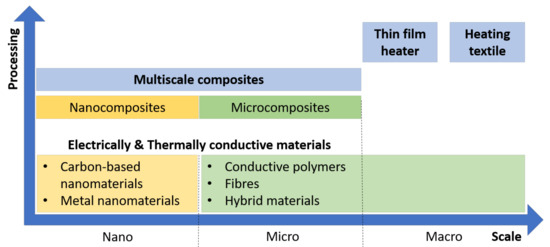1000/1000
Hot
Most Recent

Different types of heating systems have been developed lately, representing a growing interest in both the academic and industrial sectors. Based on the Joule effect, fibrous structures can produce heat once an electrical current is passed, whereby different approaches have been followed. For that purpose, materials with electrical and thermal conductivity have been explored, such as carbon-based nanomaterials, metallic nanostructures, intrinsically conducting polymers, fibers or hybrids.

| Materials | Category | Thermal Conductivity (W m−1 K−1) |
Ref. |
|---|---|---|---|
| Carbon fiber | Carbon-based | 400–650 | [5] |
| Carbon nanotubes | Carbon-based | 3000 | [5] |
| Graphite | Carbon-based | 100–400 | [6] |
| Graphene nanoplatelets | Carbon-based | 2000–6000 | [7] |
| Graphene sheets | Carbon-based | ~5000 | [8] |
| Single-walled carbon nanotubes | Carbon-based | 2000 | [8] |
| Multi-walled carbon nanotubes | Carbon-based | 3000 | [8] |
| Aluminum | Metal | 247 | [9] |
| Copper | Metal | 398 | [9] |
| Gold | Metal | 315 | [9] |
| Silver | Metal | 427 | [9] |
| Silver nanowires | Metal nanostructure | 191.5 | [10] |
| Polyacetylene | Conductive polymer | 0.4–13 | [11] |
| Polypyrrole (PPy) | Conductive polymer | 0.11–0.25 | [11] |
| Polyaniline (PANi) | Conductive polymer | 0.04–0.14 | [11] |
| Polythiophene | Conductive polymer | 0.2–4.4 | [11] |
| Poly(3,4-ethylenedioxythiophene):Polystyrenesulfonate (PEDOT:PSS) | Conductive polymer | 0.16–0.39 | [11] |
| Diamond | Ceramics | 1000 | [12] |
| Aluminum nitride | Ceramics | 100–300 | [7] |
| Beryllium oxide | Ceramics | 230–330 | [13] |
| Cubic boron nitride | Ceramics | 1000 | [14] |
| Hexagonal boron nitride | Ceramics | 300 | [14] |
| Silicon carbide | Ceramics | 120 | [15] |
| Aluminum oxide (α-Alumina) | Ceramics | 30 | [12] |